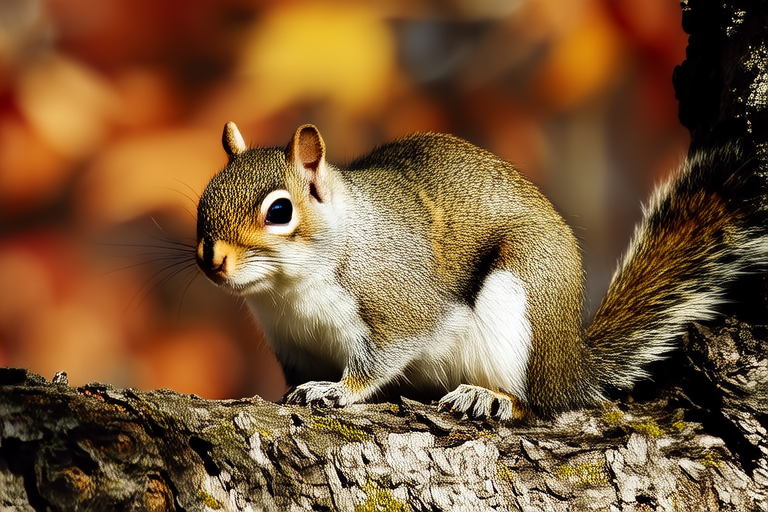From Park Rat to Social Media Sensation: The Adorable World of Squirrels
Squirrels are one of the most ubiquitous and fascinating creatures in both urban and natural settings. These agile, bushy-tailed rodents have long been a common sight in parks, forests, and even city streets. However, in recent years, they’ve made quite the leap from being merely observed park animals to becoming social media sensations. Their playful antics, endearing faces, and remarkable adaptability have won over the hearts of millions, turning them into internet stars.
The Ubiquitous Park Rat
Most people’s first encounter with a squirrel is likely in a local park. These creatures are often seen darting between trees, scampering up trunks, or foraging for food. In cities, they’ve adapted remarkably well to human environments, thriving in parks, gardens, and even bustling urban centers. Their presence is so common that it’s easy to overlook just how extraordinary they are. Yet, beneath their everyday appearance lies a world full of intriguing behaviors and unique traits.
The Transition to Social Media Sensations
With the rise of smartphones and social media, squirrels have found a new platform to showcase their talents. Videos of squirrels stealing hats, playing with toys, and even riding bicycles have gone viral, captivating audiences worldwide. These clips not only entertain but also highlight the intelligence and adaptability of these creatures. Social media has provided a window into the secret lives of squirrels, making them relatable and lovable to people who might never have encountered them in person.
Behaviors, Habitats, and Unique Traits
Squirrels exhibit a wide range of behaviors that make them fascinating to observe. They are primarily diurnal, meaning they’re most active during the day, and they spend much of their time foraging for food. Their diet consists mainly of nuts, seeds, fruits, and occasionally insects. This diverse diet helps them survive in various environments, from dense forests to urban parks.
One of the most notable traits of squirrels is their ability to store food. During autumn, they gather and bury nuts and seeds, creating hidden caches that they can retrieve later when food is scarce. This behavior, known as larder hoarding, is crucial for their survival and showcases their problem-solving skills.
There are over 200 species of squirrels worldwide, each with its own unique characteristics. For example, the American red squirrel is known for its distinctive reddish coat and its tendency to become aggressive when defending its territory. The ground squirrel, on the other hand, spends more time on the ground than in trees, burrowing underground for shelter and protection.
Dietary Preferences and Roles in Nature
Despite their varied diets, squirrels play a significant role in maintaining ecological balance. By dispersing seeds and nuts, they help in the regeneration of forests and contribute to biodiversity. In urban areas, they also serve as a form of pest control, feeding on insects that could otherwise damage plants.
The eastern gray squirrel, commonly found in North America, is particularly adept at adapting to urban environments. They’ve learned to navigate cityscapes, using power lines as highways and finding food sources in unexpected places. This adaptability has allowed them to thrive in areas where other wildlife may struggle.
Challenges in Urban Environments
While squirrels have adapted well to urban life, they still face numerous challenges. One of the biggest threats is habitat loss due to urbanization. As cities expand, green spaces shrink, reducing the availability of suitable habitats for squirrels. This can lead to increased competition for resources and higher mortality rates.
Another challenge is the risk of injury or death from vehicles. Squirrels are often hit by cars while crossing roads or trying to access food sources in busy areas. Additionally, exposure to pesticides and pollutants poses health risks to these animals.
Conservation Efforts
To address these challenges, various conservation efforts are underway. Wildlife organizations and community groups are working together to create and maintain green spaces within cities, providing safe havens for squirrels and other wildlife. Educational programs aim to raise awareness about the importance of preserving these habitats and reducing the impact of human activities on wildlife.
Efforts are also being made to reduce roadkill incidents through the installation of wildlife crossings and the promotion of safer driving practices. These measures not only benefit squirrels but also enhance overall biodiversity and ecosystem health.
Capturing Hearts Online
The reasons why squirrels have captured the hearts of millions online are multifaceted. Their playful demeanor, combined with their small size and cute faces, makes them irresistibly charming. Their ability to interact with humans in unexpected ways adds to their appeal, whether it’s a squirrel curiously inspecting a camera lens or playfully chasing after a leaf.
Moreover, their adaptability and resilience in the face of urban challenges demonstrate a remarkable spirit. Despite the obstacles they face, squirrels continue to thrive, finding innovative ways to survive and flourish in human-dominated landscapes. This resilience and charm have endeared them to people around the world, making them beloved figures in the animal kingdom.
In conclusion, squirrels have come a long way from being mere park rats to becoming social media sensations. Their unique behaviors, dietary preferences, and roles in nature make them fascinating subjects for both wildlife enthusiasts and casual observers. While they face challenges in urban environments, ongoing conservation efforts offer hope for their continued survival and prosperity. Whether you’re watching a squirrel scurry across a park or sharing a video of its antics online, there’s no denying the special place these creatures hold in our hearts.
